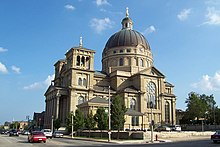St. Josaphat's Basilica
| Basilica of Saint Josaphat | |
|---|---|

The Basilica of St. Josaphat
|
|
| Basic information | |
| Location | Milwaukee, Wisconsin, United States |
| Geographic coordinates | 43°00′8.67″N 87°55′8.71″W / 43.0024083°N 87.9190861°WCoordinates: 43°00′8.67″N 87°55′8.71″W / 43.0024083°N 87.9190861°W |
| Affiliation | Roman Catholic |
| Province | Archdiocese of Milwaukee |
| Country | United States of America |
| Ecclesiastical or organizational status | Minor basilica |
| Status | Active |
| Website | Basilica of St. Josaphat |
| Architectural description | |
| Architect(s) |
Erhard Brielmaier (Architect) Gonippo Raggi (Painter) |
| Architectural type | Church |
| Architectural style | Renaissance |
| Completed | 1901 |
| Official name: Basilica of St. Josaphat | |
| Designated | March 7, 1973 |
| Reference no. | 73000089 |
| Governing Body | Private |
The Basilica of St. Josaphat, located in the Lincoln Village neighborhood of Milwaukee, Wisconsin, United States, North America, in the Archdiocese of Milwaukee, is one of 82 minor basilicas found in the United States. In its grandeur and opulence it is an excellent example of the so-called Polish Cathedral style of church architecture found in the Great Lakes region of North America. Modeled after St. Peter's Basilica in Rome, it features one of the largest copper domes in the world. It is listed on the National Register of Historic Places and is a designated Milwaukee Landmark.
The Basilica of St. Josaphat was dedicated to Josaphat Kuncevyc, a Ruthenian martyr and saint of the Roman Catholic Church, as well as of the Ukrainian Greek Catholic Church.
St. Josaphat's congregation was founded in 1888 by immigrant Poles on Milwaukee's (then) far south side. In 1896, when the parish church proved to be too small, Pastor Wilhelm Grutza commissioned a prominent church architect of the late 19th and early 20th centuries, Erhard Brielmaier. Like a number of other Polish churches in the so-called Polish Cathedral style, such as St. Mary of the Angels in Chicago or Immaculate Heart of Mary in Pittsburgh, the architectural plans for the new edifice were intentionally modeled on St. Peter's Basilica.
...
Wikipedia
